Small Polyp Stony or SPS corals are the most demanding among the main coral types. So it is not advisable for beginners to start with them unless they have prior experience with Soft and LPS corals.
Even when you have successful reef-keeping experience with the other two corals, you must not hurry and get a bunch of SPS corals before researching. Although they are usually less tolerant of mistakes, some SPS corals are comparatively lower maintenance, less delicate, and more forgiving. The wise way is to get to know them first.
Montipora, Green Bali Slimer, Club Finger, Porites, Bird’s Nest, Velvet, Leaf, and Boulder are the best SPS corals for beginners because of their limited demands and resilient temperament.
Why Are Some SPS Corals More Suitable For Beginners?
Not all SPS corals are created equal, especially in terms of ease of care. Some species are notoriously demanding, while others are more forgiving and suitable for beginners. These beginner-friendly corals typically have a higher tolerance for slight fluctuations in water quality, making them an excellent choice for those still refining their tank maintenance skills. Additionally, they often adapt better to captive environments, reducing the stress of acclimation for both the coral and its caretaker.
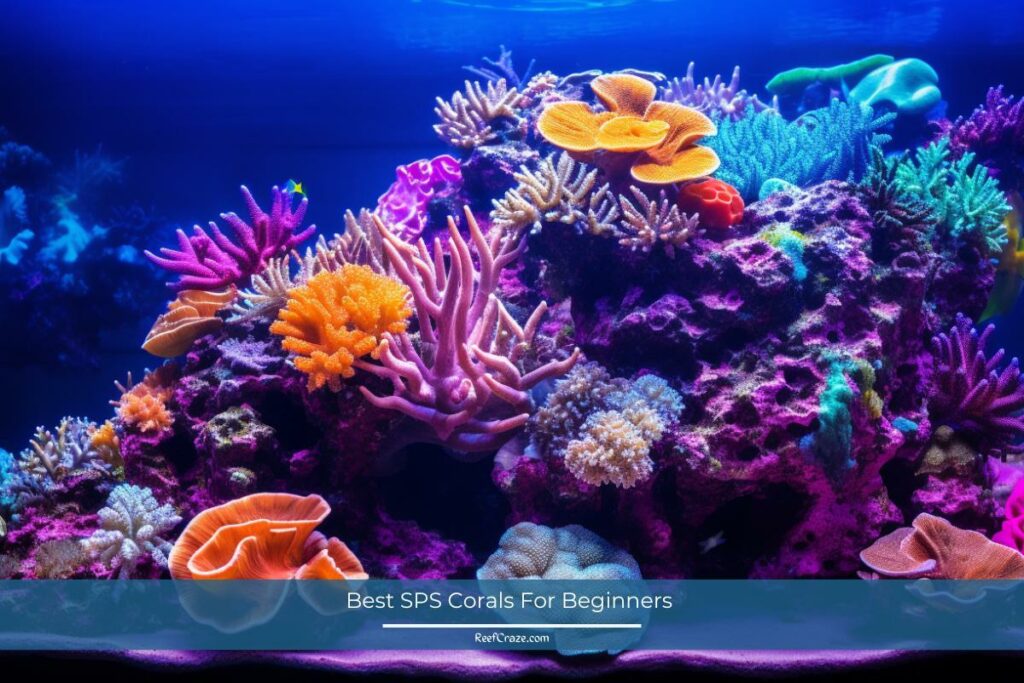
Beginner-friendly SPS corals, such as Montipora and Pocillopora, are known for their ability to adapt to a variety of tank environments. Whether it’s the strength of the lighting or the speed of the water flow, these corals can withstand a range of conditions, providing beginners a bit more flexibility in maintaining their tank.
Water quality is paramount in any reef aquarium. However, beginners might face challenges in maintaining perfect water parameters at all times. This is where beginner-friendly SPS corals come into play. Their resilience allows them to withstand temporary inconsistencies better than more delicate coral species.
Read Additionally: Difference Between Soft, LPS and SPS Corals
Common Challenges Faced by Beginners When Keeping SPS Corals
Keeping SPS corals can be a rewarding hobby, but it comes with its set of challenges, particularly for beginners. Here are some of the common issues that novice reef keepers often encounter:
- Maintaining Water Parameters
SPS corals require specific water conditions to thrive. Maintaining a consistent pH, salinity, temperature, and calcium and alkalinity levels is crucial. Fluctuations in these parameters can lead to stress and, ultimately, the decline of the corals. Beginners often struggle with keeping these parameters stable, especially in smaller aquariums where changes can occur rapidly.
- Providing Adequate Lighting and Water Flow
SPS corals have high light and water flow requirements. They rely on light for photosynthesis, and the water flow helps to deliver nutrients and remove waste. However, finding the right balance can be a challenge for beginners. Too much light or flow can damage the corals, while too little can lead to poor growth and coloration.
- Preventing and Treating Diseases
Like all living organisms, SPS corals are susceptible to diseases. Coral bleaching, brown jelly disease, and rapid tissue necrosis are just a few examples. Identifying the symptoms of these diseases and providing prompt treatment can be daunting for novice aquarists.
- Managing Aggression
SPS corals can be aggressive towards each other. They use sweeper tentacles to sting and damage neighboring corals in the competition for space. Beginners need to plan their coral placement carefully to minimize conflict and allow for growth.
- Feeding
While SPS corals primarily rely on light for nutrition, they also benefit from supplemental feeding. However, overfeeding can lead to poor water quality, while underfeeding can result in stunted growth. Beginners may find it challenging to determine the right quantity and frequency of feed.
- Choosing the Right Species
With the diversity of SPS corals available, selecting the right species for a beginner’s tank can be overwhelming. It’s important to choose species that are hardy, compatible with each other, and suited to the conditions that the beginner can provide.
While these challenges may seem daunting, they can be overcome with research, patience, and careful management. Ultimately, the joy of maintaining a thriving reef tank makes the effort worthwhile.
7 Best SPS Corals For Beginners
When you have all the equipment and supplies ready with the environmental stability of your tank, you can begin the selection process of your first-ever SPS corals.
It is fun yet challenging to maintain SPS corals, particularly for new reefers. So having success with Softies and LPS corals beforehand will bode well for them and their corals.
It means you already know how to look after them and keep up with your tank environment. Therefore, even when it gets tricky with SPS corals, you will get your way around it without sweating yourself.
SPS corals have an array of shapes, patterns, and color conditions. Each is unique with its specific needs, mandating you must know about them before adding them to your reef system.
1. Green Bali Slimer (Acropora Yongei)
Green Bali Slimers are, as their name says, green. But the shade depends on your tank lighting, varying from deep green to multiple neon hues. They show off broad branches commonly found in the Acropora family.
They populate fast after settling down in a tank. So it should have enough space to let them grow. Take that seriously because Green Bali Slimers are one of those Acropora members with the reputation of the fastest growing characteristic.
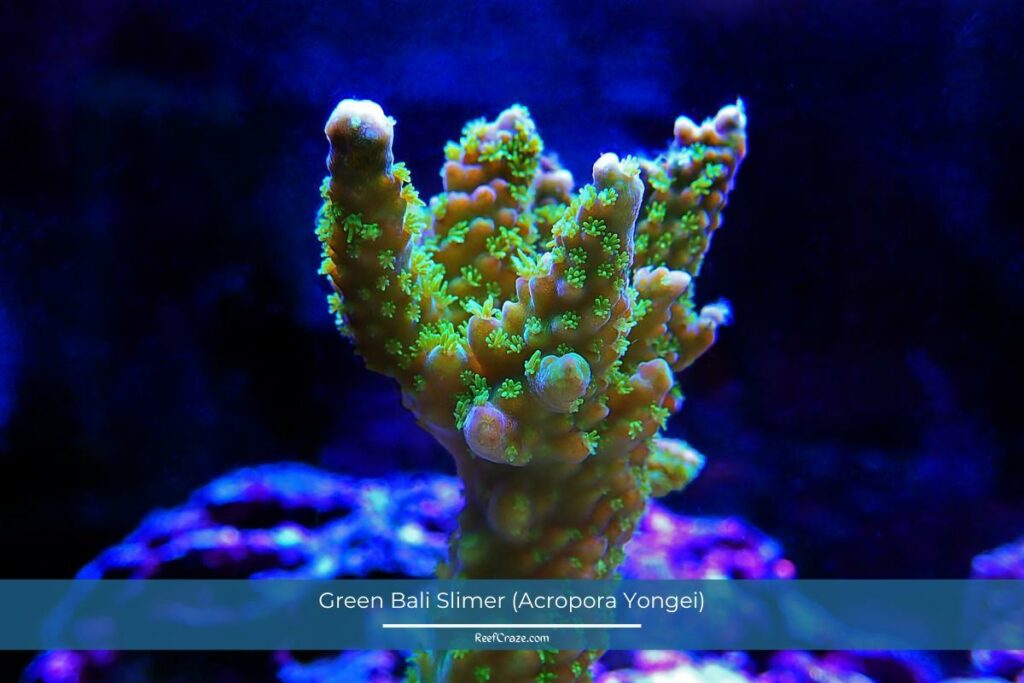
It’s essential to monitor the calcium, alkalinity, and magnesium levels in your tank as Acropora yongei uses these elements to build its calcium carbonate skeleton. Additionally, supplementing its diet with micro-plankton or fine coral foods can boost its health and growth.
| Parameter | Requirement |
|---|---|
| Care Level | Moderate |
| Lighting | Moderate to High |
| Water Flow | Strong |
| Temperament | Peaceful |
| Growth Rate | Good |
| Calcium Level | 400 – 450 ppm |
| Alkalinity | 8 – 9.5 dKH |
| Magnesium Level | 1250 – 1350 ppm |
| Supplemental Feeding | Micro-plankton or fine coral foods |
The Green Bali Slimer is undoubtedly a captivating coral to keep in your tank, but it requires consistency in care. Despite being a hardier species of Acropora, it is not immune to stress from fluctuating conditions. Therefore, maintaining stability in your tank’s environment is key to seeing this coral flourish.
Otherwise peaceful, they emit a slime-like element when bothered. They appreciate you minding your own business and letting them mind their own. The other creatures in the tank will also learn that soon.
2. Velvet Coral (Montipora Spp.)
Montipora easily scores the highest in terms of being the easiest SPS corals. It is a tiny polyp with a frizzy and charming appearance of different colors and shapes, hence its name Velvet.
It is a durable, fast grower with a high adaptability to varying lighting conditions, popular among enthusiasts and beginners. It is responsible for about 30% of the entire coral population over the globe. So, you should prepare your tank to handle its massive growth.

The water flow depends on its structure. A Monti with a plain surface prefers a gentle flow, whereas one with an uneven texture would like it strong.
You should be careful with its placement because it has a submissive temperament. Put it somewhere beyond the reach of others containing toxic chemicals or having sweeper tentacles. Plus, keep the calcium level stable to ensure their physical well-being.
| Parameter | Requirement |
|---|---|
| Care Level | Moderate |
| Lighting | Moderate to High |
| Water Flow | Moderate to High |
| Temperament | Peaceful |
| Calcium Level | 400 – 450 ppm |
| Alkalinity | 8 – 9.5 dKH |
3. Boulder Coral (Porites Spp.)
Scientists and marine experts have found Boulder corals as old as a thousand years old in the wild! Yes. However, your captive Boulder will not have that life expectancy, but you can expect slow growth anyway.
They are also categorized under encrusting corals due to their properties of sticking to solid and rocky surfaces and slow spreading growth. You will get them in many bright colors that will brighten more when kept around high-intensity lights.
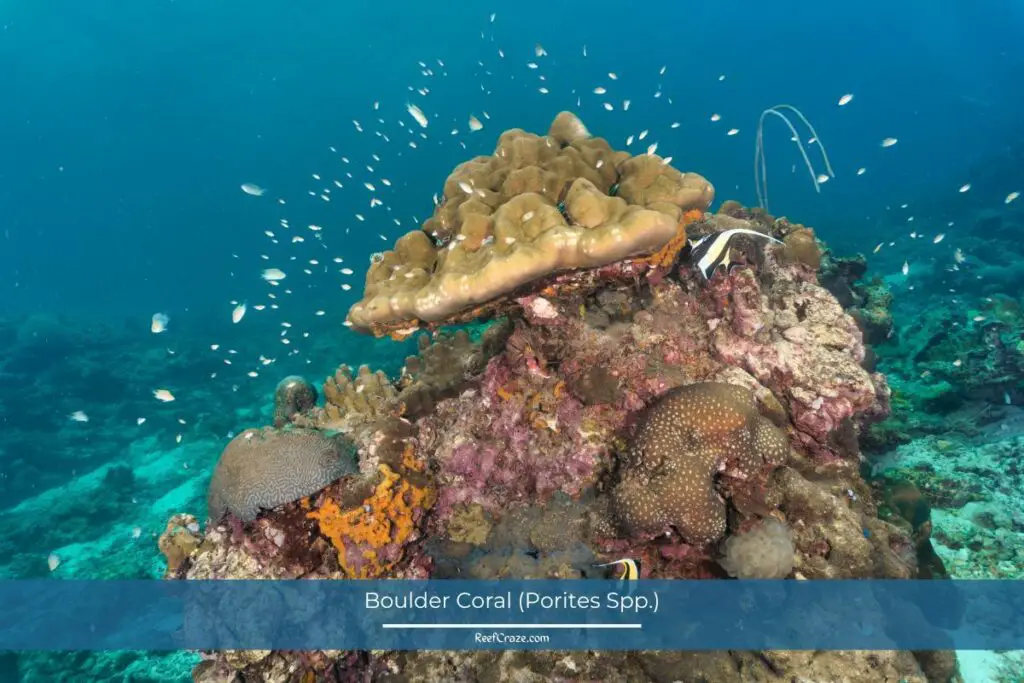
This coral has the best personality: durable, gentle, and able to regrow. If your aggressive corals attack them, they will grow again by re-calcifying their bones’ dead or wounded parts. Nonetheless, you should place them safely to keep them unharmed.
Porites are typically slow-growing but compensate for this by their longevity and resistance to disease, making them a sustainable choice for beginners. A study in Marine Biology Research suggests Porites lutea to be notably resilient to sedimentation and changes in water quality, a handy trait for novice aquarists.
| Parameter | Requirement |
|---|---|
| Care Level | Moderate |
| Lighting | Moderate to High |
| Water Flow | Moderate |
| Temperament | Peaceful |
| Resistance to Disease | High |
4. Leaf Coral (Pavona Decussata)
Leaf Corals have a tangled pattern with their upright and even fronds. There are sharp tentacles marking the surface, quite similar to cactuses.
Some Leaf Corals are bright orange and green, and some are sober with dark gray-brown and pale gray-brown. Whichever color you select will add a unique sight to your aquarium, provided with perfect lighting arrangements.

They are cute and tiny yet resilient, too, owing to their corallites that create their resistance to diseases. Again, beginners, take notes on how that makes them a suitable option for you. Moreover, remember to decorate your tank system with a robust water flow and high-level lighting for optimum growth and health.
According to a study published in the Coral Reefs Journal, Pavona cactus, in particular, has shown a significant resistance to bleaching, a common issue for reef keepers.
| Parameter | Requirement |
|---|---|
| Care Level | Easy |
| Lighting | Moderate to High |
| Water Flow | Moderate |
| Temperament | Peaceful |
| Bleaching Resistance | High |
5. Club Finger Coral (Stylophora Pistillata)
Purple, green, and pink are the most common colors of Club Finger Corals. You may also know it as Cat’s Paw coral. The pink-neon morph is the favorite coloration of maximum beginners.
They are colonist corals that branch colonies of different colors, thick with circled tips. They also travel a lot because of the ability to spread their larvae extending their parent reef.
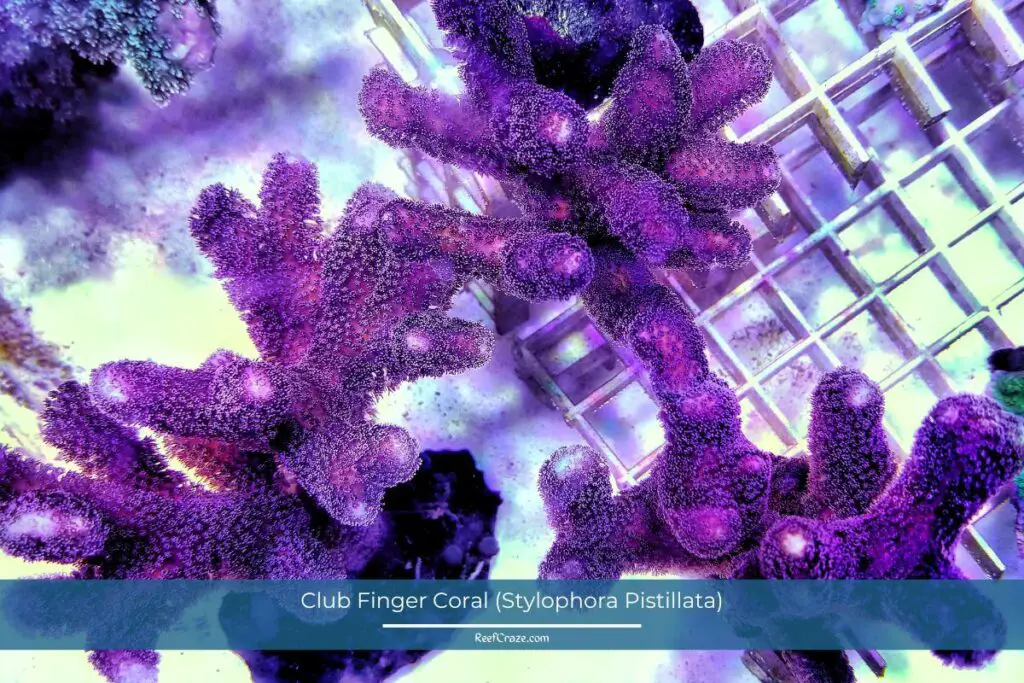
You will get the best results by arranging medium- to high-intensity lighting, particularly a T-5 fluorescent or high-powered LED light. The metal halide will do the job too.
The Pink Club Finger is notorious for its hunger. They cannot live on zooxanthellae only. So you need to feed them zooplankton or marine snow.
They extend their tentacles to hunt prey at night. Make sure you keep their tank mates distant from them. The space is also necessary to avoid a hostile tank takeover because Club Fingers grow fast and large and can uproot others if they get in the way.
Dr. James W. Fatherree, a veteran marine biologist, asserts that Stylophora, with their resilience and beautiful appearance, offer an excellent starting point for beginners venturing into the world of SPS corals.
| Parameter | Requirement |
|---|---|
| Care Level | Moderate |
| Lighting | Moderate |
| Water Flow | Moderate to High |
| Temperament | Peaceful |
| Growth Pattern | Compact Branching |
6. Bird’s Nest Coral (Seriatopora Hystrix)
It is the topmost popular SPS coral for beginners because of its easy requirements, captivating appearance, and affordable price. It comes in pink, purple, green, and yellow colors and is available in 2 kinds: one with edgy tips and another with round.
Seriatopora grows like mushrooms, so fast that it can be threatening to your tank. Also, keep the other species far from it to save them from its toxin chemical.
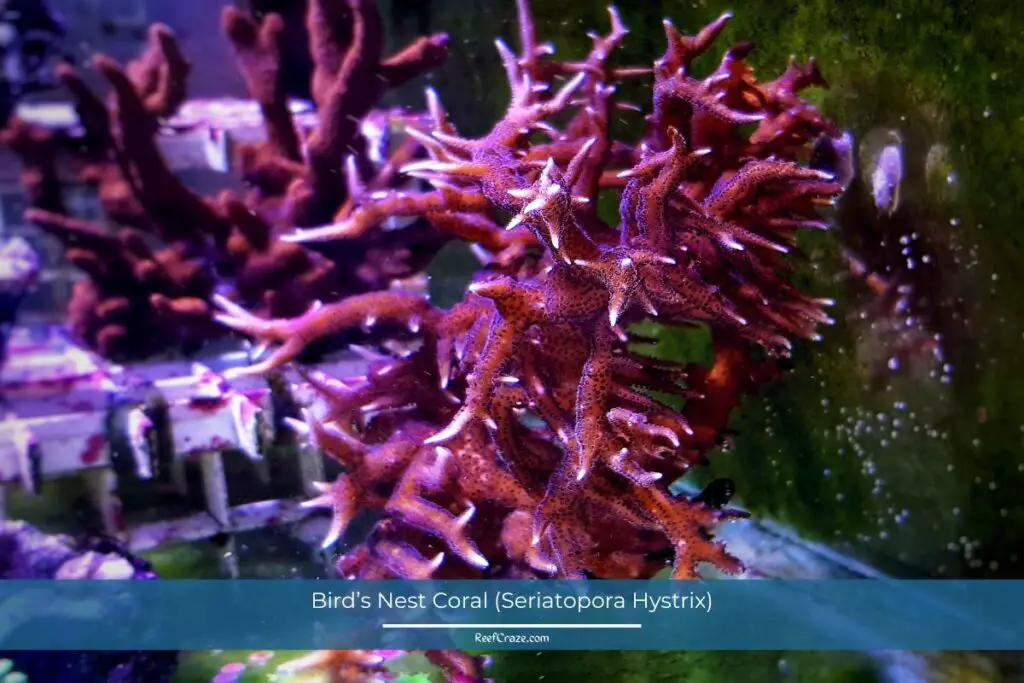
When adding the first Bird’s Nest to your tank, maintain a gentle water flow. That will keep its branches intact if they are thin. Soon it will expand its branches to become thicker. Once they do, you can raise the flow gradually.
However, their branches may still break, whether sharp or blunt. Do not worry about that because they will regrow quickly. Stay careful when handling the sharp ones, as they can puncture your skin.
While birdsnest corals are generally hardy, regular feeding of zooplankton can optimize their health and growth, as per a research study in the Marine Ecology Progress Series.
| Parameter | Requirement |
|---|---|
| Care Level | Moderate |
| Lighting | Moderate to High |
| Water Flow | High |
| Temperament | Peaceful |
| Feed | Zooplankton |
7. Hydnophora Coral
Hydnophora, or Horn corals, stand out with their unique, spiky appearance and are available in a range of vibrant colors. While they are slightly more challenging to keep than others on this list, they can be a worthwhile venture for beginners who have gained a little experience and confidence.
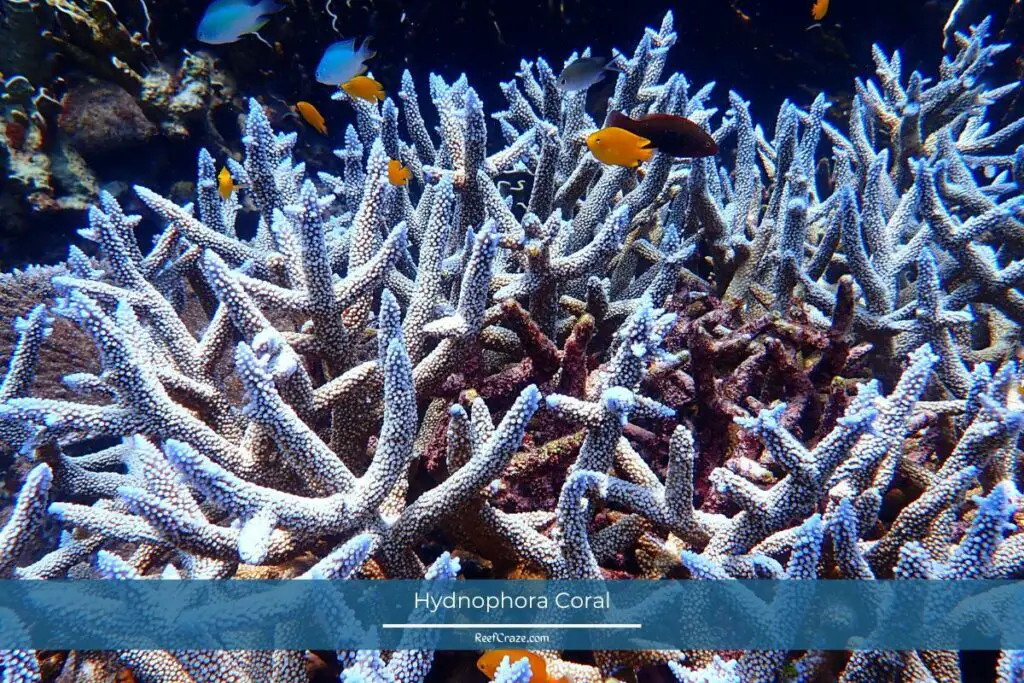
These corals demand high light and water flow and should be given ample space as they can be more aggressive towards their neighbors. An article in the Journal of Experimental Marine Biology and Ecology highlighted the relatively high growth rate of Hydnophora, which, while demanding careful management, can offer a rewarding experience for those willing to take the plunge.
| Parameter | Requirement |
|---|---|
| Care Level | Moderate to High |
| Lighting | High |
| Water Flow | High |
| Temperament | Semi-aggressive |
| Growth Rate | High |
Buying Guide for Beginner-Friendly SPS Corals
Before plunging into the vibrant world of SPS corals, understanding what to look for when purchasing these beautiful organisms is crucial. We will discuss the important considerations for a beginner, such as the size and growth rate, overall health, and compatibility of the coral.
1. Size and growth rate of coral
In the realm of SPS corals, size and growth rates vary significantly. According to a study published in the Journal of Marine Biology, species like Montipora are known for their fast growth rates, whereas Stylophora are slow growers. As a beginner, you might prefer corals with a moderate growth rate. This pace provides a balance, allowing you to observe progress without the coral quickly outgrowing your tank.
2. The overall health of coral
The health of the coral is a vital aspect to consider. Observing the coral’s color and polyp behavior can give you clues about its health. Healthy corals typically display vibrant colors and have all their polyps open. If you see signs of discoloration, retracted polyps, or tissue recession, these could indicate stress or illness. Dr. Andrew Bruckner, a renowned coral researcher, suggests beginners familiarize themselves with common coral diseases and pests to avoid introducing these into their tanks.
3. Compatibility with other tank inhabitants
Just like animals in the wild, corals interact with their environment and fellow inhabitants. In their natural habitat, according to the Marine Biodiversity Records, some SPS corals have been observed to engage in chemical warfare for space, a process called allelopathy. It’s essential to ensure the corals you introduce to your tank are compatible with existing inhabitants to avoid such conflicts.
4. Reliable sources for purchasing
It’s not just about what you buy, but also where you buy your corals. Let’s look at both online coral retailers and local fish stores as viable options for your purchases.
1. Online coral retailers: With advancements in technology, buying corals online has become increasingly popular. Retailers like LiveAquaria and Unique Corals offer a vast selection of SPS corals suitable for beginners. They provide detailed descriptions, care requirements, and sometimes even videos of the corals, helping you make an informed decision.
2. Local fish stores: While online shopping may offer convenience, local fish stores provide a different set of advantages. You can personally inspect the coral, observe its condition, and ask store employees for advice. Some reputable stores include Aquatic Warehouse in California and Manhattan Aquariums in New York City.
SPS Coral Care Guide For Beginners
SPS corals are the most sensitive to changes. So you should be extra careful in maintaining the water parameters and other care requirements suggested below. As far as they are stable, you have nothing to worry about your corals.
| Water Parameters / Care Requirements | Range / Level |
| Alkalinity | 7 to 10 dKH |
| Calcium | 400 to 450 ppm |
| Magnesium | 1200 to 1400 ppm |
| Phosphate | <0.1 ppm |
| Nitrate | 5 to 20 ppm |
| Lighting and water flow | Moderate to high |
| pH | 8.1 to 8.4 |
| Salinity | 1.025 to 1.028 |
| Temperature | 72 to 78 degrees of Fahrenheit |
1. Proper Lighting and Water Flow
SPS corals rely heavily on lighting for their energy needs, conducting photosynthesis through their symbiotic zooxanthellae. According to the Coral Reef Journal, SPS corals thrive under high-intensity light, but the exact requirement can vary based on the species. LED lights with adjustable intensity and spectrum can be a good choice for beginners.
SPS corals also require adequate water flow. The Oceanography Society states that water flow aids in nutrient delivery, waste removal, and the prevention of sediment accumulation on the corals. A combination of turbulent and laminar flow usually works best for SPS corals.
2. Nutrient and Water Quality Management
SPS corals are sensitive to water chemistry. They require stable conditions with the right balance of calcium, alkalinity, and magnesium. According to the National Oceanic and Atmospheric Administration (NOAA), maintaining these levels is crucial for coral growth and health.
Regular testing of water parameters is essential. Test kits are available to measure levels of salinity, pH, ammonia, nitrate, nitrite, phosphate, calcium, alkalinity, and magnesium. The Australian Institute of Marine Science advises that, as a general rule, SPS corals prefer a salinity between 1.024 and 1.026, a pH between 8.1 and 8.4, and a temperature between 75 and 78°F.
Regular water changes help maintain stable water chemistry by removing excess nutrients and replenishing essential elements. Experts at the Marine Biological Association recommend changing 10-20% of the tank water every two weeks.
3. Feeding SPS Corals
While most SPS corals derive their nutrition from light through photosynthesis, they can also capture plankton and other small particles from the water. Researchers from the Smithsonian Marine Station suggest that feeding SPS corals a small amount of zooplankton or coral food once a week can supplement their nutritional needs.
SPS corals have been known to consume a variety of foods. Marine snow, a mixture of organic particles that fall from the upper layers of the ocean, phytoplankton, and commercially available coral foods can all be part of an SPS coral’s diet.
Common Problems and Troubleshooting
Even with the best care, problems can arise when keeping SPS corals. Being able to identify and address common issues like bleaching, tissue recession, and algae overgrowth is an important part of coral care.
1. Bleaching
Coral bleaching is a common issue, often caused by environmental stress. During bleaching events, corals expel their symbiotic zooxanthellae, causing them to turn white. The National Coral Reef Institute points out that elevated water temperatures are a common cause of coral bleaching.
If you observe coral bleaching, first check your water temperature and quality. As suggested by NOAA, gradually lowering the water temperature and improving water quality can help corals recover. However, recovery can take several weeks or even months.
2. Tissue recession
Tissue recession, where the coral’s tissue recedes to expose its skeleton, can be a sign of poor water quality or disease. The Coral Disease Handbook suggests that increased nitrate levels, pests, or physical damage can all contribute to this issue.
Tissue recession can often be halted by improving water quality, removing pests, or isolating affected corals to prevent the spread of potential diseases. A study published in the Coral Reefs Journal advises that maintaining optimum water conditions is the best preventive measure.
3. Algae overgrowth
Algae overgrowth is another common problem in coral tanks. According to the Journal of Experimental Marine Biology and Ecology, algae can outcompete corals for space and light, inhibiting coral growth and sometimes leading to their death.
Preventing algae overgrowth involves maintaining good water quality, limiting nutrients (like nitrates and phosphates) that fuel algae growth, and introducing algae-eating species to the tank. The Aquaculture journal notes that sea urchins, certain types of snails, and tang fish are all efficient algae eaters. If algae overgrowth is already an issue, manual removal, combined with these measures, can help restore balance.
Final Words
A piece of advice to help you if you really consider having this high-maintenance coral is to build a habit of testing the quality of your tank water. Always monitor your tank environment and test the water parameters. If you cannot frequently do that, at least take care of the alkalinity and phosphate levels.
It is the only effective way to keep your SPS corals healthy. Do not target adding corals. Instead, be consistent with the ones you begin with because it takes enough time, funding, and effort to maintain even a few of them.
Do not be in a hurry to make changes. It should be a gradual process. Remember to pick corals based on your expertise and perform coral dipping before taking new ones to your aquarium. Lastly and importantly, enjoy reef-keeping!
